30. Federal Courts and the Silver Admiralty Oar
Located: Center stairway, mezzanine levelExhibited in courthouse: Silver Oar of Admiralty, District of New Hampshire
Other images of interest: photos of Silver Admiralty Oars of Massachusetts and New York
The oar exhibited in our courthouse is a symbolic representation of the link between colonial-era British admiralty courts and the current District Courts of the United States.
Admiralty (maritime) law was formally adjudicated in England as early as 1360. A mace in the shape of an oar, made of silver, was used to symbolize the power of the British admiralty courts. It was commonly carried by the court’s marshal, and placed before the judge during trials.
Vice-admiralty courts were established in several colonial American cities. Some of these courts also used silver oars to symbolize their authority under the British crown. After the American colonies won independence from Great Britain and established their own judicial system, admiralty jurisdiction was placed with the federal district courts.
The silver oar displayed in the Warren G. Rudman courthouse was designed to replicate the two remaining original silver oars of colonial America, those of Boston’s and New York’s vice-admiralty courts. This exhibit honors the rich history and admiralty authority of the United States District Courts.

Federal Courts and the Silver Admiralty Oar
While it is not commonly known, there is a direct historical link between the colonial era British admiralty courts and the current federal court system in the United States. The silver oar that is displayed in the lobby of the Warren B. Rudman U.S. Courthouse is a symbolic representation of that link.
Admiralty law, also known as maritime law,i is thought by some to have existed as far back as 900 B.C. on the island of Rhodes in the eastern Mediterranean. Whatever its origin, admiralty law is an ancient civil law-based legal system consisting of rules and principles derived from long-standing customs of the sea, judicial decisions, legislative enactments, international treaties, as well as a host of medieval maritime codes.
Admiralty law was introduced into England by Eleanor of Aquitaine while she was acting as regent for her son, King Richard the Lionheart. English maritime matters were heard by the High Court of Admiralty, which emerged in London around 1360. Subsequently, Vice Admiralty Courts were established in various port cities in England and Wales. Initially, these admiralty courts addressed cases involving piracy and naval discipline but, gradually, they extended their jurisdiction to commercial matters. Cases in these British admiralty courts were decided solely by a judge and individuals appearing before the court did not have the right to a jury trial.
Traditionally, English admiralty courts had two areas of jurisdiction: Prize and Instance. Prize jurisdiction was the private property of an enemy, captured at sea, which included cargo as well as the vessel itself. This jurisdiction was important because, during the sixteenth and seventeenth centuries, England was commonly at war with other countries. In contrast, instance jurisdiction included private litigation brought at the instance of the plaintiff against a vessel. Seamen with unpaid wages, suits for salvage, and suits on bottomry bondsii were most commonly brought in the High Court of Admiralty and Vice Admiralty Courts.
America's admiralty law heritage is naturally linked to the English admiralty courts and originated when the first Vice Admiralty Court in the American and West Indian colonies was established in Jamaica in 1662. Vice Admiralty Courts in the British colonies had the same jurisdiction, structure and procedure as the admiralty courts in England, but heard cases in British possessions beyond the seas. These courts were used in some of the colonial east coast seafaring ports to resolve issues relating to the British sea transport industry, as twelve of the thirteen original American colonies had anchorages on the Atlantic seaboard. Boston, New York, Philadelphia, Charleston, and possibly sites in Maryland and/or Virginia each hosted British Admiralty Courts. Specifically, the Vice Admiralty Court established in Boston had jurisdiction in all cases arising within the limits of the colonies of New Hampshire, Massachusetts Bay, Rhode Island and Connecticut. Many American lawyers who were prominent in the American Revolution, such as Alexander Hamilton of New York and John Adams of Massachusetts, were admiralty and maritime lawyers in their private lives.
As the seventeenth century came to a close, global political discord was about to cause a change in the world order. In 1696, in an effort to increase monies deposited into the royal treasury, British Parliament decided to enforce the ANavigation Acts. These acts mandated that only ships built, owned and registered in Britain could trade with the American colonies, that the master and three-quarters of the crew must be British, and that merchandise freight going to or from any other European country to the American colonies must make a stop in England to pay a duty. Vice Admiralty Courts in the American colonies had the responsibility of enforcing this law, which had a dramatic impact on foreign trade with the colonies.
Anti-British sentiments grew during the first half of the 18th century as these non-jury Vice Admiralty Courts in North America were given expanded jurisdiction to hear criminal and civil matters involving colonists (to their displeasure) and to enforce additional trade policies enacted by the British Parliament, such as The Stamp Act of 1765iii and The Townshend Acts 1767iv. These developments, when combined with a new generation of colonists born in America who increasingly regarded England as a foreign country, served as a source of resentment against Great Britain that culminated in the American Revolutionary War.
After the American colonies declared their independence from Great Britain, each state assumed for itself the powers of sovereignty, such as control of the judicial system, except to the extent such powers were limited by the Articles of Confederation. Thus, many states merely extended the existence, jurisdiction and authority of the prior Vice Admiralty Courts under state authority by commission or by newly enacted state legislation. In New Hampshire, by state statute such matters were to be resolved by the New Hampshire Court Maritime.
In 1789, the Articles of Confederation were replaced by the United States Constitution which, regarding admiralty jurisdiction, provides in Article 3 ' 2 that the judicial power of the United States, Ashall extend Y to all cases of admiralty and maritime jurisdiction. The Judiciary Act of the same year established thirteen judicial districts within the eleven states that had ratified the Constitutionv and conferred original jurisdiction. This means, essentially, that if a maritime claimant wishes to have his claim litigated in accordance with admiralty procedure, he must invoke the admiralty jurisdiction of the federal district court.
So, you may be asking what is the connection between the present day federal court system as it has developed from colonial times and a silver oar? In medieval times, reading and writing were uncommon abilities among lay people. For this reason, valuable objects such as crowns and scepters were used to symbolize power. The High Courts of the Crown were no different in that they employed a silver macevi that displayed the royal arms on it to indicate the authority of whoever carried it.
Similarly, Marshal of the Admiralty Court, who attended to the needs of the court, also carried a silver oar that most likely derived from the silver mace concept. The Marshal would carry this oar with him when delivering warrants and at the execution of convicted sailors and pirates and it sat on the bench in front of the judge during maritime trials. Possibly the most notorious appearance of the silver oar was during public executions. For example, on May 23, 1701, Captain William Kidd and six of his associates were hanged as pirates in London on the Thames River at Wapping Old Stairs. The Admiralty Court Marshal, bearing the silver oar, led the procession from London's Newgate Prison to the gallows.
The silver oar was also used by the Marshals in the Vice Admiralty Courts in the British colonies. Unfortunately, numerous colonial artifacts, but especially symbols of British authority such as the silver oar, were lost during the American Revolutionary War. Some were melted down for their silver, while others were destroyed or reused as armaments. The former was no doubt the fate of the lost silver oars. Today, the only two known surviving silver admiralty oars from the colonial Vice Admiralty Courts are from Boston and New York.
A Vice Admiralty Court was established in Boston in 1694, which, as noted above, had jurisdiction over the New Hampshire colony. Boston's silver oar was made by a talented silversmith named Jacob Hurd between the years 1740 and 1750. The oar is twenty-three and one half inches long and is said to derive from a ship's steering oar rather than a rowing oar. On one side of the oar, the Royal Arms is pictured along with the initials AG R, which corresponds to George Rex, who was rumored to be an illegitimate son of King George III and was a Marshal of the Vice Admiralty Court in Cape Colony. Various alternations to the shield occurred over the years as successive kings acquired or claimed other realms. The motto of the Order of the Garter is a french phrase that reads Honi soit qui mal y pene, which encircles the shield. Although Jacob Hurd was a well-known and respected silversmith in his day, he misspelled the last word of the phrase, which was supposed to read Apense. In any event, the entire phrase means Aevil to him who thinks evil. On the reverse side of the oar, there is an anchor with a rope flowing around it to symbolize admiralty law. Although many of the silver oars in England are much more elaborately detailed, Boston's silver oar has a more simplistic appeal to it, which is most likely attributed to the Puritanical lifestyle of its creator.
Boston's silver oar was carried by the last Marshal of the Vice Admiralty Court, Arodi Thayer. Thayer, a Loyalist, was responsible for arresting John Hancock when he smuggled a load of Madeira wine on his ship, The Liberty. Thayer was exiled in 1776 and brought the silver oar with him to Halifax, Nova Scotia, then to New York City, and then to London. Thayer and the oar ultimately returned to Dorchester, Massachusetts, where he passed away in 1831. Thayer's daughters gave the oar to the Dorchester Antiquarian and Historical Society, which eventually disbanded. The oar was next given to the Massachusetts Historical Society, which loaned it to the New England Historic and Genealogical Society in 1871. The oar is currently on loan to the Museum of Fine Arts in Boston where it is on display.
The second surviving oar is from the Vice Admiralty Court in New York, which was established in 1678. The court received its silver oar, made by American silversmith Charles Le Roux, in 1737. The American Revolutionary War caused the court in New York to disband in 1775. Thomas Ludlow, Jr., the Marshal at that time, brought the silver oar home with him and it was retained by his heirs as their personal property until one of them pledged it as security for a bank loan in 1939. The oar was subsequently purchased for $2,500.00 by a group of thirty New York admiralty law firms and it was presented to the District Court for the Southern District of New York in 1941.
Thus, these remaining silver oars represent a connection between the first colonial courts in North America and the current federal court system. There are no records of any colonial Vice Admiralty Courts located in New Hampshire. Had one been established, however, its silver oar most likely would have resembled the one on display at the Warren B. Rudman U.S. Federal District Courthouse.
iThe laws and regulations, including international agreements and treaties, which exclusively govern activities at sea or in any navigable waters.
iiBottomry bonds refers to a mortgage contract in which a ship is pledged as security for a loan for equipment, repair, or use of a vessel.
iiiThe Stamp Act of 1765 required that all legal documents, newspapers, pamphlets, and playing cards in the colonies display a tax stamp.
iv The Townshend Act of 1767 levied tax on common imported products such as lead, paper, paint, glass, and tea, it created three new admiralty courts to try Americans, and it reaffirmed the legality of writs of assistance, which gave tax collectors permission to search for smuggled goods.
vMost of the states were comprised of one judicial district. However, Virginia and Massachusetts each contained two judicial districts. A portion of the Massachusetts district was subsequently divided to become the District of Maine. The District of Kentucky was originally a part of District of Virginia. Once Kentucky was apportioned, the District of Virginia geographically consisted of what we know today to be the Districts of Virginia and West Virginia.
viIn medieval times, mace originally was a term used to describe a spiked club, which was used as a weapon to break through chain mail or damage armor plate.


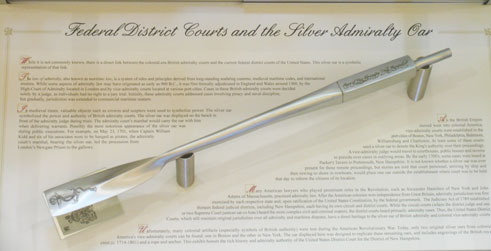
Silver Oar of Admiralty, District of New Hampshire
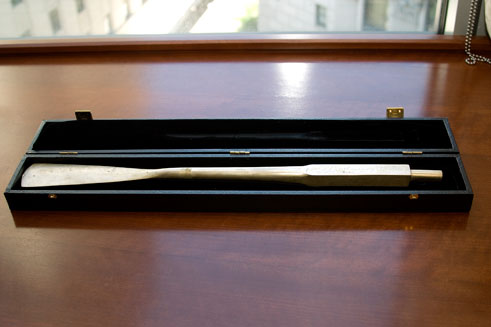
Silver Admiralty Oar of New York
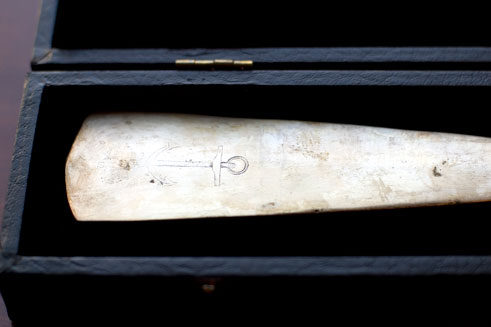
Silver Admiralty Oar of New York
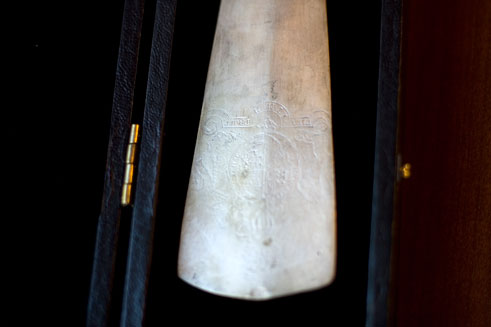
Silver Admiralty Oar of New York
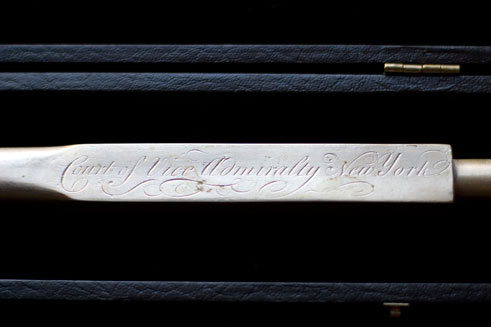
Silver Admiralty Oar of New York
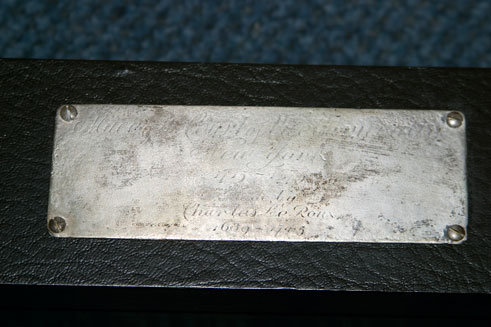
Silver Admiralty Oar of New York

Silver Admiralty Oar of Massachusetts
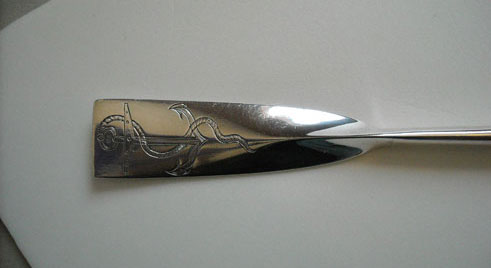
Silver Admiralty Oar of Massachusetts
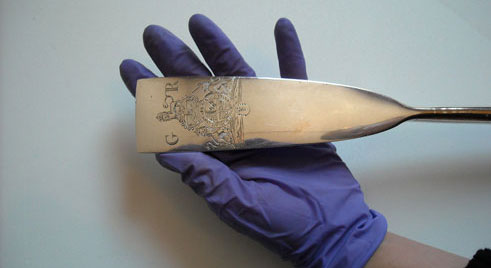
Silver Admiralty Oar of Massachusetts



